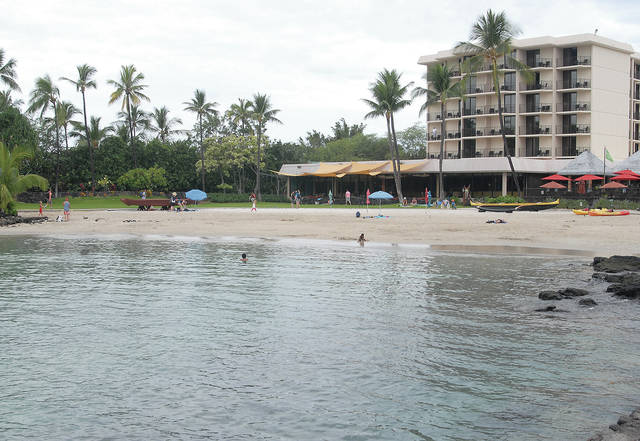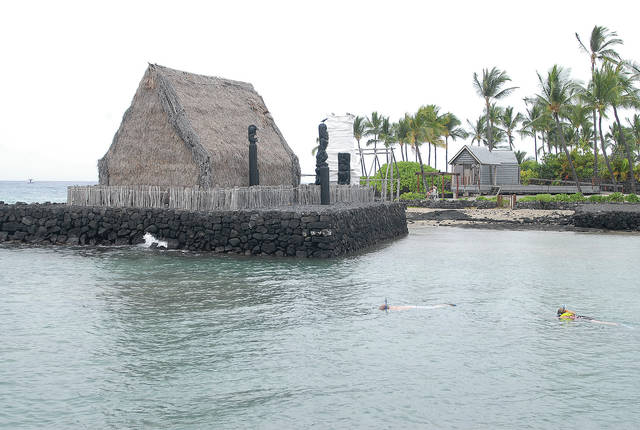KAILUA-KONA — Advisory signs at Kamakahonu Beach at Kailua Bay came down Friday after tests for pathogen indicators fell below Clean Water Branch thresholds. ADVERTISING KAILUA-KONA — Advisory signs at Kamakahonu Beach at Kailua Bay came down Friday after tests
KAILUA-KONA — Advisory signs at Kamakahonu Beach at Kailua Bay came down Friday after tests for pathogen indicators fell below Clean Water Branch thresholds.
Signs were first posted after a test on Feb. 21 showed enterococci levels, an indicator of possible pathogens, at 453 colony-forming units per 100 milliliters of water, according to CWB water quality data. The branch’s threshold is 130 units per 100 milliliters of water.
Myron Honda, an environmental health specialist at the Department of Health’s Clean Water Branch, said advisory signs go up within about 24 hours of a test showing elevated levels of enterococci at a particular site.
Some visitors to the island though said they never saw any signs or notices about potential health hazards at the beach.
Corey Shelby, visiting from Alaska, said he hadn’t seen any indication that the water might be unsafe.
“I’ve been here for two weeks and haven’t seen any signs,” he said.
Given that he has four kids playing in the water, he said he’d want to know if there were any health risks associated.
Kevin Anderson, who’s visiting from Seattle, said he’d only seen reports about Kahaluu Beach Park, which was closed indefinitely on Friday because of a wastewater discharge onto the beach and into beach waters.
“We hadn’t heard anything about this beach,” he said at Kamakahonu Beach on Wednesday.
He said there ought to be more mindfulness of guests and clearer, more obvious signs to help him decide what’s best for his family.
Kamakahonu Beach, also called Kailua Pier Station D in water quality reports, is considered a “Tier 1” beach by the Clean Water Branch. Tier 1 beaches, Honda explained, are “core beaches,” which are heavily used and may be more threatened by some type of pollution.
Tier 1 beaches are tested every week.
In those tests, the Clean Water Branch looks for specific pollutants, including enterococci, a pathogen indicator.
Historically, Honda said, that’s been used to determine sewage contamination.
“So the thinking back then was if you can find the enterococci, then it follows that that water body may be contaminated with sewage and therefore, you may be prone to the pathogens that are found in sewage,” he said.
The presence of enterococci could be caused by several things, such as a leaking sewage system or contamination with waste.
The Clean Water Branch, Honda said, hasn’t received any reports of sewage spills in the area of the pier. Holders of discharge permits must report spills to the Department of Health, he noted.
“We haven’t received any complaints or evidence of sewage leaks,” he said.
Honda noted that a contamination could be from several years ago, given that the indicators grow in soil with warm temperatures. Whereas in the mainland, winters can freeze the bacteria and cause them to die out, here in Hawaii, they live year-round.
Studies, he added, have also shown that the organisms can grow in soil even in the absence of sewage spills. Certain feral animals, such as cats, dogs and pigs, can also harbor the bacteria.
“The source isn’t human-specific,” Honda said.
Federal law requires the Clean Water Branch to notify the public that there may be risks associated with swimming in an area any time enterococci levels reach the 130-level threshold in the area.
“As soon as we reach a number greater than 130, then we’re required to notify the public,” said Honda.
They don’t have the authority to close a beach, Honda said, but they can put out notices and advisories.
If elevated enterococci levels turn up during routine testing at a given site site, follow-up testing occurs every working day until the number falls back below 130.
Until then, he added, the advisories stay up.
The high levels of enterococci at Kamakahonu Beach aren’t typical for that area, according to historical reports.
Every test since the beginning of this year has shown levels to be 2.3 and only one test in all of 2016 has had a test result above 130, when levels hit 254 at the beginning of November.
As to why measurements were so high during last month’s test, Honda said it could be a number of reasons, such as heavy rains or high surf.
Heavy wave action, he said, could stir up beach sand containing enterococci.
Alternatively, rain in the mountains could be flowing into storm drains and running off into the beach area.
The signs at the beach were pulled on Friday after levels fell back below 130. Daily testing, Honda said, did take place, but he didn’t have the updated results.
The most recent sample was scheduled to be taken Wednesday, he added, with the results to be made available today.
Advisories were restricted exclusively to the Kamakahonu area of the bay.
A test taken at Kailua Pier Station A, located about 915 feet away from Kamakahonu Beach, showed enterococci levels of 2.3 units per 100 milliliters of water. That sample was taken 15 minutes before the sample that triggered advisories at Kamakahonu Beach.
Honda said the vast difference between the two sites could be because Station D tends to have poor circulation as a result of its relatively enclosed shape. Station A, he added, is a larger, more open bay and not as prone to that effect.




